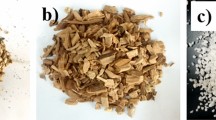Abstract
Steam conditioning of softwood boards after kiln drying is of critical importance for relief of residual drying stresses and to improve distribution of final moisture content. The conditioning practice in New Zealand includes two steps: immediately after high temperature (HT) drying the load is cooled until the core wood temperature is 75 to 90°C, and then the stack is steam conditioned for a period of 1 to 4 hours depending on the lumber thickness and moisture content after drying. In this work, experimental and theoretical studies were performed to better understand the conditioning process and to investigate factors which influence its effectiveness. In the experiment, 50 mm thick Pinus radiata sapwood boards were first dried at 120/70°C for 11, 12, 13, 16 and 18 hours, respectively, to varying moisture contents, and then cooled and steam conditioned for 1 hour. To assess the effectiveness of conditioning, moisture pick-up, moisture gradient, and transverse residual drying stress (indicated by cup and strain) were measured. It was found that drying wood to a low moisture content (below 6%) increased the conditioning effectiveness. A separate matched stack was conditioned for 4 hours after 13 hours drying which showed better results than 1 hour conditioning. A mathematical model for wood drying was extended to include both the cooling and conditioning phases. The model was numerically solved to examine the wood temperature and moisture content changes during the whole process of drying, cooling and final steam conditioning. Increase in wood temperature, moisture pickup and moisture gradient during steam conditioning were predicted and validated by the experimental data. This information is currently being used at the New Zealand Forest Research Institute in simulation of stress development and relief for drying of Pinus radiata lumber.
Similar content being viewed by others
Author information
Authors and Affiliations
Additional information
Received 6 July 1998
Rights and permissions
About this article
Cite this article
Pang, S., Simpson, I. & Haslett, T. Cooling and steam conditioning after high-temperature drying of Pinus radiata board: experimental investigation and mathematical modelling. Wood Science and Technology 35, 487–502 (2001). https://doi.org/10.1007/s00226-001-0124-2
Issue Date:
DOI: https://doi.org/10.1007/s00226-001-0124-2




